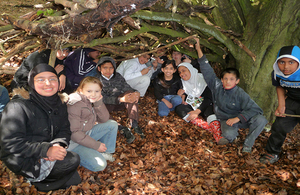Children’s visits to natural environments: new evidence
Report provides new evidence on the scale and scope of visits to natural environments made by children in England.

Youngsters enjoying an outdoors visit to the Aston Rowant National Nature Reserve © Jenny Hanwell/Natural England
A new report reveals, for the first time, the scale and scope of the visits children in England make to natural environments, including parks, playgrounds and woodlands.
Natural England, Defra, English Heritage and King’s College London have been working with the Monitor of Engagement with the Natural Environment (MENE) survey to find out about the visits children make to natural environments; where they go, how often and who with.
MENE, which has national statistics status, previously only surveyed adults over 16. Last year, the survey also included new questions relating specifically to children’s visits, to gather more comprehensive and representative data.
Report results
The results show a link between social inequalities and the opportunities that children have to experience the natural environment. It also highlights the importance of local greenspace to all children - especially those who visit less frequently.
Many children visit frequently, but a significant minority never visit:
- 70% of children (around 7 million children) visited the natural environment at least once a week
- 12% (around 1.3 million) rarely, if ever, visited the natural environment
- there are regional variations - for example, more children living in the north east of England took frequent visits than children living in the west midlands or London (74%, 64% and 62% respectively)
The frequency of children’s visits is linked to ethnicity and socio-economic status:
- children from non-black, Asian and minority ethnic households were more likely to visit frequently than those from black, Asian and minority ethnic households (73% compared to 59%)
- children from higher income households were more likely to visit frequently than children from lower income households (77% compared to 64%)
There are strong links between adult and child visiting behaviours:
- in households where the adults were frequent visitors to the natural environment, 80% of children were also frequent visitors; in households where the adults rarely (or never) visited, only 39% of children visited frequently
- in an average month:
- 76% of children visited with the adults from their own household
- 15% of children took visits with their grandparents
- 10% of children visited with their schools or teachers (although children in the DE socio-economic group were only half as likely to visit the natural environment with their school as those in the AB group)
- 22% of children took visits to the natural environment without any adults present (on their own or with other children)
Most children’s visits were to local natural environments:
- local natural environments were important to all groups studied regardless of ethnicity or socio-economic status. In an average month, 47% of all children (4.8 million) visited local urban parks
The main annual MENE report was published in January 2015 and highlights the increasing importance of health and wellbeing as important factors motivating people to visit the natural environment. Natural England is using this, and other MENE analysis, to help target and evaluate its work.
Dr Tim Hill, Natural England’s chief scientist said:
For the first time, the MENE survey provides data to help us understand the scale and scope of children’s engagement with the natural environment across England. The report reveals significant inequalities in how children engage with the natural environment.
Given the evidence to show links between how access to greenspace affects our health, the information which MENE is providing is vital and incredibly useful for us, and for the many other organisations that are looking to better target and measure the impact of policies and projects at all ages across the country.
Professor Kevin Fenton, national director of health and wellbeing, Public Health England added:
Making it easier and encouraging more children to enjoy the natural environment is an important part of their physical, mental and emotional development. It underpins the work to address childhood obesity, inactivity and ensuring every child has the best start in life.
We are delighted to be in partnership with Natural England to deliver the Children’s Indicator pilot which will support the health and environment sectors to drive up levels of physical activity and help reduce obesity, especially amongst children.
Data from the pilot has been adopted by the Office of National Statistics as part of their indicator set for children’s wellbeing. It will be used by Defra as part of their indicator set for monitoring delivery of the Natural Environment White Paper and by Public Health England to complement their public health outcomes data.